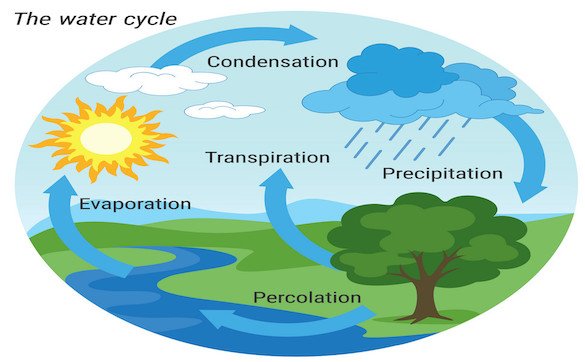DAV Class 7 SST Chapter 5 Solutions
DAV Class 7 SST Chapter 5 Solutions Water Surrounding the Earth, help students in framing the answers for the exercise questions. Chapter 5 Water Surrounding the Earth solutions are provided by our experienced faculty and cover all the key topics. Referring to this solutions, will give students an idea of how to express answers in the exams.
Practicing DAV Class 7 SST Chapter 5 Solutions questions will ensure that students are well exposed to all types of questions that can be framed in the examination. These DAV Solutions highlight the main topics and concepts from the DAV Class 7 Social Science textbooks.
DAV Class 7 Social Science Chapter 5 Question Answer Water Surrounding the Earth
DAV class 7 sst chapter 5 question answer Water Surrounding the Earth is given below. Here DAV class 7 social science solutions is provided with great explanation. Here we will solve fill in the blanks, tick the correct option, short and long question.
Highlights
- A. Tick the correct option.
- B. Fill in the blanks.
- C. Give a technical term.
- D. Answer the following questions in brief.
- E. Answer the following questions.
A. Tick the correct option.
1. The water cycle is-
Answer: the continuous movement of water
2. The three states of water are-
Answer: solid, liquid, gas
3. What turns water on the earth into vapours in the water cycle?
Answer: the sun
4. When clouds get too heavy to hold water-
Answer: the water falls on the earth.
5. In coastal areas, warm ocean currents cause-
Answer: rainfall
B. Fill in the blanks.
1. The largest natural source of water is ___________.
2. When the level of ocean water rises, it is a ___________ tide.
3. ___________ port in India is an example of tidal port.
4. Tidal energy is a ___________ source of energy.
5. Cold currents flow along the ___________ coast of the oceans.
Answer: (1) oceans (2) high (3) Kolkata (4) renewable (5) sea
C. Give a technical term for each of the following statements.

Answer: (1) Evaporation (2) Water cycle (3) Waves (4) Rainwater (5) Tides
D. Answer the following questions in brief.
1. On what factors does the height of a wave depend?
Answer: The height of a wave depends on the speed, strength and duration of the wind.
2. Define an ocean current.
Answer: The ocean current is the continuous movement of mass of water in a particular direction.
3. How are tides caused?
Answer: Tides are caused due to the gravitational pull of the moon and the sun. Tides occur twice a day. When the level of water rises, it is a high tide and when the level falls, it is a low tide.
4. Name the important components of the water cycle.
Answer: The important components of the water cycle are sun and water.
5. Name three valuable resources which are found in abundance in the ocean.
Answer: Copper, nickel and cobalt are the valuable resources found in the ocean.
E. Answer the following questions.
1. How are tides useful to us?
Answer: Tidal energy is harnessed to generate electricity in the coastal areas. Tidal energy is one of the important renewable sources of energy. Sometimes, high tide enables big ships to enter the harbour or sail out of the harbour.
2. How are oceans beneficial to us in improving the quality of life?
Answer: The oceans facilitate countries and regions to trade with one another. Transportation through oceans is cheaper than any other mode of transport. The marine environment provides animal and plant life for food and trade in abundance. Mineral oil, magnesium, gold, platinum, nickel, copper and cobalt are some of the valuable minerals found in different parts of the ocean. By this way oceans are beneficial to us in improving the quality of life.
3. Explain the water cycle with the help of a diagram.
Answer: Water of the ocean is converted into water vapours due to the heat of the sun by the process of evaporation. The evaporated vapours rise up in the atmosphere and condensed into tiny crystals of ice or droplets of water to form clouds. When the water droplets grow in size and are unable to float, they fall down over the earth’s surface as precipitation. It is because of this never-ending circulation; this process is called Water cycle.

4. Explain three effects of ocean currents.
Answer: The three effects of ocean currents are:
- It influences the climate of the coastal regions of the continents.
- Warm ocean currents rise the temperature and cause rainfall in coastal areas.
- Cold ocean currents lower the temperature and make the climate cool and dry.
5. Suggest four ways to help people affected by devastation due to Tsunami.
Answer: The four ways to help people affected by devastation due to Tsunami are:
(i) Try to provide a relief to the victims by donating money, clothes, medicines, etc.
(ii) Make a list of people lost and keep advertising till every family is united and supply them with food and water.
(iii) Move them to safe place and make them feel everything is going to be fine. (iv) Bring first aid and medical help as soon as possible.

nice ????????????????????????????????????
Nice
Nice answers are there
Nice I like it
Pls. Make small answer
It’s already so short
Thanks for this tomorrow is my exam i didn’t have this chapter In my class work copy but I get it from your link thanku so much
????????????
Thanks for giving me all q & ans of lessons ????????????????????????????????????????
Thanks, it helps me a lot ????
????????????????????????
Nice it is helpful to every student who study in dav school. ????????????????????
Out standing .????????????????
Yes this web is too good but if we get map skills also so it will be too good for us
So simple and easy solution
In last question you didn’t give fourth point